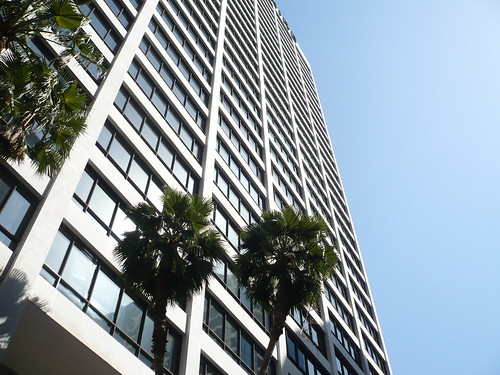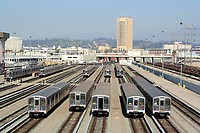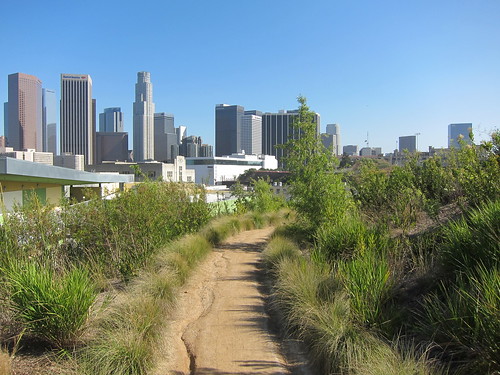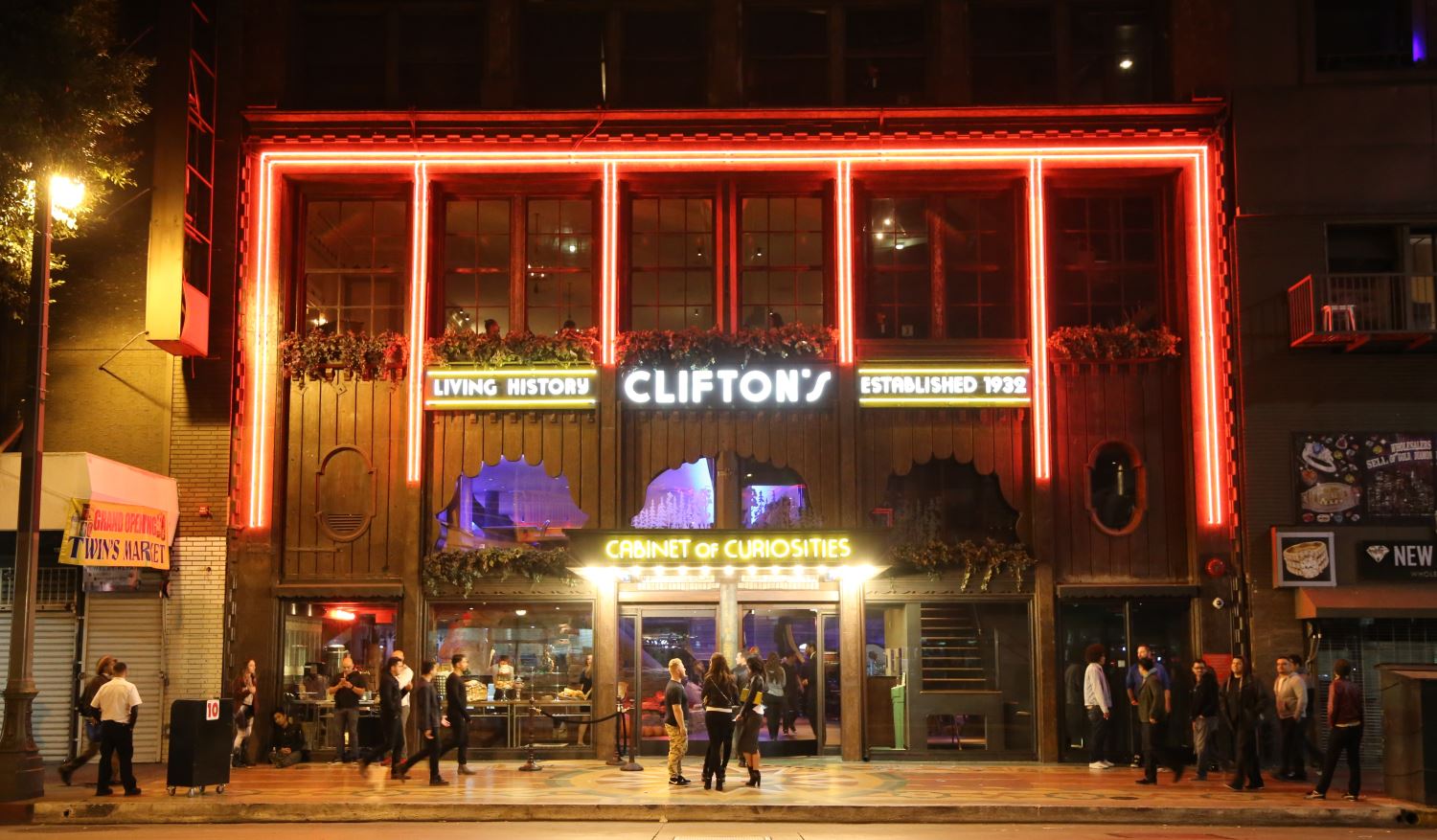Click here for larger map!
The year closes with
CicLAvia
XXIV, the fifth of five Los Angeles open streets events in 2017! Our Epic CicLAvia Tour returns to
iconic Wilshire Boulevard for the first time since August, 2015, this time with an extra half-mile added at the east end of the four-mile route, incorporating a small section of previous "Heart of L.A." CicLAvia iterations. So this Epic CicLAvia Tour guide is basically a re-run of the 2015 route, with a few extras added on for your enjoyment. Enjoy CicLAvia on Sunday. You may or may
not see The Militant on the streets!
1. Spring Street Park
2013
428 S. Spring St, Downtown
A former parking lot turned into urban park in June 2013 to satiate the open-space and recreational needs of the new DTLA residential population, this plot of land, in its short history, has already accumulated a list of challenges with regards to its management, upkeep and (ab)use, from un-leashed dogs to people misusing the facilities. Nevertheless, the space does perform its role as a green oasis within the built city core.
2. Broadway-Spring Arcade Building
1924
541 S. Spring St, Downtown
This unique building is actually three, opened in 1924 on the site of
Mercantile Place,
a 40-foot street cut between 5th and 6th streets connecting Broadway
and Spring. Mercantile Place was a popular shopping and gathering locale
in the early 1900s. Having fallen into decay by the 1970s, it was
recently renovated and is now famous for, of all things, vendors selling
rock band t-shirts. It also becomes an artistic venue during the
DTLA ArtWalk. And The Militant probably doesn't need to mention that this building is home to the DTLA
Guisado's.
 3. Site of Original Ralphs Supermarket
3. Site of Original Ralphs Supermarket
1873
6th and Spring streets, Downtown
Before
the Hotel Hayward building was built in 1905, George A. Ralphs (see,
that's why there's no apostrophe) and his brother Walter B. started the
Ralphs Bros. Grocers on the southwest corner of 6th and Spring.
Their company still continues to this day, and in 2007, the company that started in DTLA
returned to the area after some 50 years.
4. St. Vincent Court
1868
St. Vincent Ct and 7th Street, Downtown
You'd
hardly knew it was there, but this alley nestled between Broadway and
Hill (blink and you'll miss it!), with its decorative brick pavement and
European decor, seemingly belongs to another world. Originally the site
of a Catholic college that was
the predecessor of today's Loyola Marymount University, today it's a unique food court featuring Armenian and Middle Eastern eateries. The Militant calls it, "Littler Armenia."
Check out this Militant Angeleno post on St. Vincent Court from 2008 for more info.
5. One Wilshire Building/Wilshire Bookend Palm Trees
1966
624 S. Grand Ave, Downtown
Built
during the first wave of modern skyscrapers following the repeal of Los
Angeles' building height limit laws, this building, designed by
architectural rockstars
Skidmore, Owings and Merrill (who
also went on to craft Chicago's Sears Tower, among many others) stood
for most of its life as the address of legal and financial institutions.
After a renovation in 1992, this building is now the location of
CoreSite, a major data colocation center, which carries the primary Internet connections for Los Angeles (without this building,
you can't read this!)
Take
note of the row of palm trees, planted here in the 1970s: They are
meant to evoke the end of Wilshire Boulevard, as on the opposite end, at
Santa Monica's Ocean Avenue, 16 miles from here, you will also find a
row of palm trees.
6. Wilshire Grand Center
2017
900 Wilshire Blvd, Downtown
On this site rises the new
Wilshire Grand Center, Los Angeles' (and the West's -- suck on it,
Transbay Tower SF!)
tallest building at 73 stories and 1,100 feet (kinda sorta, there's a
spire, you see...). Opened on June 23, it is the city's only modern skyscraper
without a flat roof, the only Los Angeles building since Hollywood's Capitol Records tower in 1956 to feature a spire, the
first skyscraper anywhere to sport a mohawk, and it also has its own irreverent
Twitter account. ;)
Owned by Korean Air (hence the red and blue
taeguk LED logo), the tower houses the 900-room
Hotel Intercontinental with its 70th-floor Sky Lobby and the unique Spire 73 skybar, with wonderful views of the south and west (the sunset vista from here is not to be missed).
The building's construction site was the
location of "The Big Pour" - which lasted from February 15 -16, 2014,
where 21,200 cubic yards (81 million pounds) of concrete for the tower's foundation were
continuously poured - earning it
a Guinness World Record for that feat.
Before the skyscaper, the site was home of the Wilshire Grand Hotel,
formerly (in reverse chronological order) the Omni Hotel, Los Angeles
Hilton, Statler Hilton and Statler Hotel.
7. L.A. Prime Matter Sculpture
1991
Wilshire and Figueroa (NW corner), Downtown
Wilshire
is full of awesome-looking public art. Here's one relatively-recent
sculpture,
recently renovated, right at the northwest corner of Wilshire and Figueroa.
Designed by the late Venice-based artist
Eric Orr, who had a penchant for utilizing elemental themes in his art,
L.A. Prime Matter features
twin 32-foot bronze columns that feature water sliding down its faces,
and during random moments, FIRE emanates from the middle channels of the
columns every hour on the hour! The effect is total bad-ass, and its bad-assnes is magnified
at night.
8. Site of George Shatto Residence/Good Samaritan Hospital
1891
Wilshire Blvd and Lucas Ave, Downtown
Before
it was named Wilshire Boulevard, it was once called Orange Street, and
on the corner of Orange and Lucas was a Queen Anne-style mansion
belonging to George Shatto, a real estate developer who first developed
Catalina Island and the city of Avalon. If you read the
Epic CicLAvia Tour 4.0 post, his name is brought up as one of the famous Angelenos buried (in a rather ornate pyramid) at Angelus Rosedale Cemetery.
But check this out! Take
a look at the picture above, and pay close attention to the masonry
wall going uphill that fronts Lucas Avenue. Now, on CicLAvia Sunday,
look at the exact same spot, on the northwest corner of the
intersection. The house is gone, but the original wall
still remains!
Good Samaritan Hospital,
which was founded in 1885 and moved to the current site in 1911, is
also the birthplace of many native Angelenos, including mayor
Eric Garcetti.
9. Los Angeles Teachers (a.k.a. 'Stand And Deliver') Mural
1997
Wilshire and Alvarado, Westlake
Art imitates life imitating art imitating life in
this mural by popular Salvadoreño American muralist
Hector Ponce depicting actor Edward James Olmos, who portrayed Garfield High School math teacher Jaime Escalante in the 1988 movie
Stand and Deliver, standing
next to the real-life Escalante, and delivering a mural that's
part-Hollywood, part-Los Angeles, part-Latino pride, part Eastside pride
and if the Internet were as accessible back in 1988 as it is today,
would make one epic photo meme. And it's painted behind the 1926
Westlake Theatre, which is slated for renovation into a community-baed performance arts venue sometime soon. Celebrate the 25th anniversary of
Stand and Deliver by having the
ganas to stop by.
10. Gen. Harrison Gray Otis Statue
1920
Wilshire Blvd and Park View Ave, MacArthur Park
Gen.
Otis is perhaps the most visible statue at the park, which predates
MacArthur's WWII service. This general served in the Spanish-American
and Philippine-American wars, and also fought as a Union soldier in the
Civil War. But in Los Angeles, he is most known for being the founder,
owner and publisher of the Los Angeles Times. So why is he here? His
Wilshire Blvd mansion, called The Bivouac, was located across the
street, was later donated to Los Angeles County and became the original
campus of
Otis Art Institute. It's thought that his statue is pointing to the site of the Elks Lodge, but he's probably just pointing to his old house.
11. Bryson Apartment Building
1913
2701 Wilshire Blvd, MacArthur Park
This
10-story Beaux Arts apartment building, built 100 years ago, was the
20th century precursor to today's fancy modern 21-century high-rise
residential developments. Built by developer Hugh W. Bryson, it was
built in a part of Los Angeles that was known at the time as "the west
side" (let's not open that can of worms right now, okay?). It was one of
Los Angeles' most luxurious apartment buildings, and had a large neon
sign at the roof (characteristic of these kinds of developments back
then). Several Raymond Chandler books reference The Bryson. The 110,000
square-foot building is also part of the National Register of Historic
Places and a Los Angeles Historic-Cultural Monument.
12. Lafayette Park
1899
Wilshire Blvd and LaFayette Park Place, LaFayette Park
Clara
Shatto, the widow of George Shatto (remember him?) donated 35 acres of
her land to the City of Los Angeles in 1899, which was once oil wells
and tar pits. Her late husband wanted it turned into a city park, and so
it became Sunset Park, which existed for 19 years before the locals
wanted it renamed to honor the 18th-century Frenchman who was a hero in
both the American and French revolutions. Gotta give LaFayette park some
props for living so long in the shadow of its more famous neighbor,
MacArthur (Westlake) Park.
13. Bullocks Wilshire/Southwestern Law School
1929
3050 Wilshire Blvd
Perhaps
one of the most iconic examples of Art-Deco architecture in Los
Angeles, this former Bullocks Department Store was designed with a tower
to resemble a New York-style skyscraper in then-unabashedly low-rise
Los Angeles. It was the epitome of shopping in style in its heyday, with
its own rear parking lot and other auto-centric amenities. It
ultimately fell victim to the 1992 Los Angeles Riots and was closed down
the next year. In 1994, the nearby
Southwestern School of Law bought the building and incorporated it into its campus, restoring much of the Roaring 1920s Art Deco aesthetics.
14. Shatto Place
c. 1880s
Wilshire Blvd and Shatto Pl, Koreatown
Gee,
we can't get seem to get away from that George Shatto guy, can we?
George and Clara owned a plot of land here on this street, which was
once home to some of the most beautiful mansions in Los Angeles at the
time. Although Clara sold the land in 1904, George stipulated that all
properties on the street maintain the character of the exquisite homes
there, which was challenged several times until the late 1920s, when the
homes started to be demolished in favor of more modern commercial
development.
15. "The Vermont" Highrise Apartment Development
2014
Wilshire Blvd and Vermont Ave., Koreatown
This 30- and 25- story highrise mixed-use apartment development is called "The Vermont" by
J.H. Snyder Co. which opened in 2014. It's Metro-accessible, and it has a friggin'
Pizza Rev, but who the hell can afford the rents for this place?
16. Consulate Row
Various locations along Wilshire Blvd between Vermont and Crenshaw
Some
62 countries have consular offices in the Los Angeles area and 41 of
them have addresses on Wilshire Boulevard. Proximity to various foreign
financial institutions on Wilshire, as well as nearby Hancock Park,
where many consul-generals have traditionally resided, are the main
reasons for such a high concentration of consulates on this stretch of
Wilshire. The consulate offices for Bangladesh, Bolivia, El Salvador,
Ethiopia, Guatemala, Honduras, Indonesia, South Korea, Nicaragua, Peru,
The Philippines, Sri Lanka and Taiwan are all located on
Wilshire between Vermont and Crenshaw. Many of them display their
national flags in front of their respective office buildings. How many
can you spot during CicLAvia?
17. Gaylord Apartments
1924
3355 Wilshire Blvd
Though
the building's prominent neon sign has been source of many a snicker by
immature junior high school kids, this building represents some serious
history. It was named after Wilshire Boulevard's namesake, Henry
Gaylord Wilshire, who was known as a wealthy real estate developer and
outspoken socialist (Does that make sense?), who donated a 35-acre strip
of barley fields to the City of Los Angeles on the condition that it
would be free from railroads or trucking.
The building itself is
a 13-story Italian Renaissance-style apartment building that actor John
Barrymore (a.k.a. Drew's grandpa) and then-presidential candidate
Richard Nixon once called home.
18. Brown Derby Site
1926
3427 and 3377 Wilshire Blvd
The
now-defunct "The Brown Derby" local chain of restaurants were
synonymous with Hollywood glitz and glamour. The Wilshire Boulevard
location was the first of four (the others were in Hollywood, Beverly
Hills and Los Feliz). In close proximity to The Ambassador Hotel and its
Cocoanut Grove swing/jazz club, this was the original hipster joint
back in the day, only back then the hipsters were actually cool and
looked good. In 1937 the building was moved across the street and closed
in 1975. In 1980, a shopping center was built on the site and the
iconic dome structure was incorporated into the shopping center that
exists today. It's situated on the third floor, above The Boiling Crab
seafood restaurant. It's something to ponder on while you wait 90
minutes for your table.
Note that the pictures for #17 and #18 connect vertically - that's the Gaylord Apartments behind the Brown Derby!
19. Robert F. Kennedy Inspiration Park/Ambassador Hotel Site
2010
Wilshire Blvd between Catalina Street and Mariposa Avenue
The Militant
wrote a post in 2010 about
this unique public space dedicated to Sen. Robert F. Kennedy, who was
assassinated just yards away at the Ambassador Hotel, which was
demolished in 2005 and where the LAUSD's sprawling and costly RFK
Community Schools campus now stands. There's Kennedy quotes on public
art installations and benches for you to chill on. There's also speakers
playing recordings of some of the jazz music that was performed at the
hotel's famed Cocoanut Grove swing and jazz club.
20. Wiltern Theatre/Pellissier Building
1931
Wilshire Blvd and Western Avenue (duh...), Koreatown
The
12-story structure, designed by Stiles O. Clements, is Los Angeles'
emerald-green temple to all that is Art Deco. Originally operating as
the "Warner Theatre" (Specifically the Western Avenue location of Warner
Bros. chain of movie theaters; The Warner Theatre in San Pedro is
another example), The Wiltern (named so since 1935) has seen many cycles
of decay and rebirth, most recently in the 1980s, when preservationists
renovated the theatre to a performing arts venue. The contemporary
Wiltern Theatre has been operating since 1985.
21. MaDang Courtyard
2010
621 S. Western Ave, Koreatown
The heart of K-town is essentially the revived district once known as Wilshire Center, a mid-rise commercial district which emerged in the mid-1960s, filling in the commercial real estate gap between Downtown and Miracle Mile. By the late 1980s, the district had fallen into disarray, with many businesses closing down or moving out, culminating around the time of the 1992 Riots (the iconic Bullocks Wilshire closed down in 1993). With the old guard having moved out, it allowed opportunities for the then-scattered Korean business community, fueled by an abundant supply of investment money from South Korea, to move into the vacant retail and office spaces and expand Koreatown into the large district that exists today. Enter MaDang Courtyard, which opened in 2010. This dense, triple-story urban mall represents not only the modern Koreatown, but a more of a visual semblance of Seoul, as opposed to the re-purposed commercial spaces of the old Wilshire Center. Anchored by the
CGV Cinemas multiplex, which screens current Hollywood features, Korean films and Korean-subtitled versions of mainstream blockbusters, you can't get more K-town than that (for a non-food establishment). But speaking of food establishment, there's also a
Hansol Noodle location here, a
Paris Baguette (despite the francophone name, it's a South Korean bakery cafe chain), a
Lemon Tree kids' play cafe and Japanese imports
Daiso (picture a Nippon version of the 99 Cents Only store) and pastry chain
Beard Papa's. It's like a trip across the Pacific (minus the jet-lag).
Happy CicLAvia! See you or not see you on the streets on Sunday!
































.jpg/1200px-Southern_Pacific_Arcade_Station_on_Alameda_Street_between_Fourth_Street_%26_Sixth_Street%2C_ca.1895-1900_(CHS-4258).jpg)











.jpg/1024px-Los_Angeles_Times_building%2C_after_the_bombing_disaster_on_October_1%2C_1910_(CHS-5728).jpg)
/cdn.vox-cdn.com/uploads/chorus_asset/file/4396681/00012812.0.jpg)





